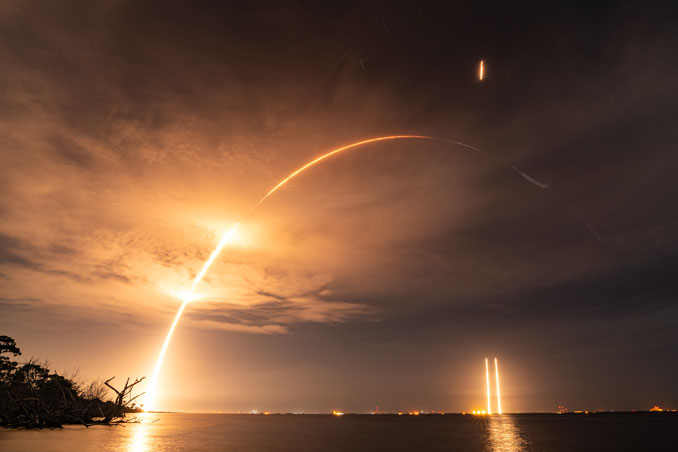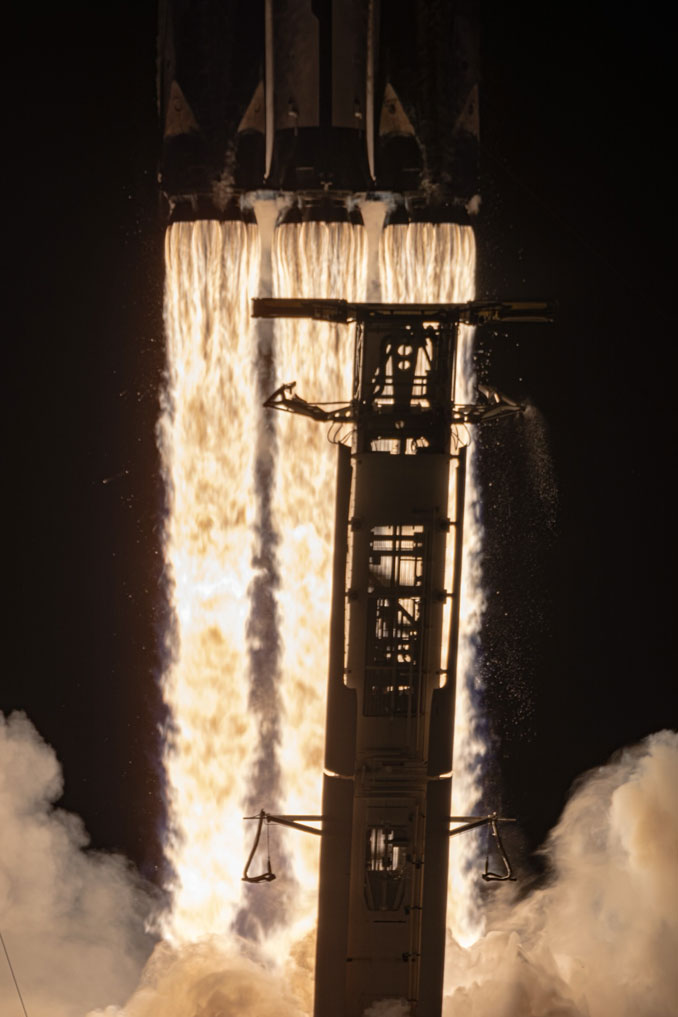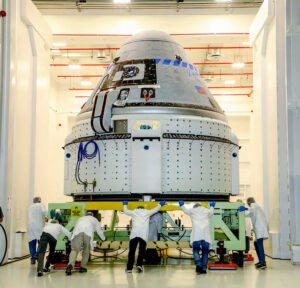
SpaceX launched the world’s heaviest commercial communications satellite atop a Falcon Heavy rocket on Friday. The triple-core rocket lifted off from Kennedy Space Center’s pad 39A with the Jupiter 3/EchoStar 24 satellite at 11:04 p.m. EDT (0304 UTC Saturday).
The successful launch came after a scrub on Wednesday and a 48-hour delay to replace a stuck liquid oxygen valve on the rocket’s port-side booster. After a week of stormy conditions on the Florida Space Coast the weather improved and the rocket lifted off in calm conditions, with just a thin layer of cloud in the sky.
It was the seventh mission for the Falcon Heavy and the third flight of the rocket this year. The Falcon Heavy’s twin side boosters, which have made two previous flights, returned to SpaceX’s Landing Zones 1 & 2 punching through a thin layer of cloud and announcing their arrival with sonic booms. The rocket’s core stage required all its capacity to loft the giant satellite into a geostationary transfer orbit and was not recovered.

The Jupiter 3/EchoStar 24 satellite, housed inside the rocket’s payload fairing, was the heaviest commercial communications satellite ever launched. The 9-metric-ton satellite will expand reach of the HughesNet satellite internet service to nearly 80 percent of the population across the Americas. It features 300 spot beams to target coverage and has 500 Gbps of capacity.
The Falcon Heavy upper stage performed three burns to place the satellite into a geostationary transfer orbit. Spacecraft deployment occurred about three and a half hours after launch.
Sharyn Nerenberg, the vice president of corporate communications at EchoStar, said following launch, Jupiter 3 will go through the process of orbit raising and testing as it arrives in its orbital slot of 95 degrees West longitude. It will take the place of EchoStar’s Spaceway 3 satellite, which launched back on Aug. 14, 2007.
“The Hughes’ Jupiter fleet of satellites is actually the largest Ka-band fleet across the Americas,” Nerenberg said. “It’s comprised of the Jupiter 1 satellite, the Jupiter 2 satellite, three hosted payloads over Latin America and soon, the Jupiter 3 satellite.”
EchoStar was relying on the Falcon Heavy for this launch because it needs the capability of a heavy lift rocket for such a massive satellite. The previous Jupiter missions used Arianespace’s Ariane 5 in 2012 and ULA’s Atlas V rocket in 2016.

Nerenberg said launching to geostationary orbit allows them to reach more people with fewer satellites.
“A geostationary satellite is proven, it’s time-tested and they’re great at laying down dense broadband capacity right where our customers need it the most,” Nerenburg said. “And so, Jupiter 3 was designed to do exactly that. It was custom designed to lay down the most capacity possible where we know our customers really need it.”
She said the improved broadband connectivity is designed to help those in rural areas of the Americas.
“Additionally, Jupiter 3 is going to be great for cellular backhaul for mobile network operators, helping them extend reach to more people beyond where their terrestrial towers can reach,” Nerenberg said. “It’s also going to be used for aeronautical connectivity, for WiFi in the sky for airplanes traveling across North and South America. They’ll be able to have higher speeds in flight.”
Service using Jupiter 3 is expected to begin this fall in the fourth quarter of 2023, according toe Nerenberg.
- SEO Powered Content & PR Distribution. Get Amplified Today.
- PlatoData.Network Vertical Generative Ai. Empower Yourself. Access Here.
- PlatoAiStream. Web3 Intelligence. Knowledge Amplified. Access Here.
- PlatoESG. Automotive / EVs, Carbon, CleanTech, Energy, Environment, Solar, Waste Management. Access Here.
- BlockOffsets. Modernizing Environmental Offset Ownership. Access Here.
- Source: https://spaceflightnow.com/2023/07/29/falcon-heavy-launches-heaviest-commercial-communications-satellite-yet/
- :has
- :is
- :not
- :where
- ][p
- 1
- 11
- 14
- 2012
- 2016
- 2023
- 24
- 27
- 300
- 500
- 80
- a
- Able
- About
- According
- across
- actually
- After
- Airplanes
- All
- allows
- also
- america
- Americas
- and
- Announcing
- areas
- arrival
- Arrives
- AS
- At
- atlas
- Aug
- back
- BE
- because
- before
- begin
- Beyond
- booster
- BOOSTERS
- broadband
- burns
- came
- camera
- CAN
- capability
- Capacity
- cellular
- Cloud
- Coast
- commercial
- Communications
- Comprised
- conditions
- Connectivity
- Core
- Corporate
- coverage
- custom
- Customers
- delay
- dense
- deployment
- designed
- do
- down
- Engines
- entry
- Ether (ETH)
- EVER
- exactly
- Expand
- expected
- Exposure
- extend
- falcon
- Fall
- Features
- fewer
- First
- FLEET
- flight
- Flights
- florida
- following
- For
- Fourth
- Friday
- from
- giant
- Go
- going
- great
- Half
- Have
- heavy
- help
- helping
- higher
- hosted
- HOURS
- http
- HTTPS
- image
- improved
- in
- inside
- Internet
- into
- IT
- ITS
- jpg
- Jupiter
- just
- Know
- landing
- largest
- Latin
- latin america
- launch
- launched
- launches
- launching
- lay
- layer
- Lifted
- Liquid
- Long
- made
- massive
- max-width
- merlin
- Michael
- minutes
- Mission
- missions
- Mobile
- more
- most
- nearly
- Need
- needs
- network
- North
- now
- occurred
- of
- off
- on
- operators
- Orbit
- our
- over
- Oxygen
- pad
- People
- percent
- perform
- performed
- Place
- plato
- Plato Data Intelligence
- PlatoData
- population
- possible
- Powering
- president
- previous
- process
- proven
- Quarter
- raising
- reach
- really
- relying
- remote
- replace
- required
- right
- rocket
- Rural
- Rural Areas
- Said
- satellite
- satellites
- saturday
- service
- side
- sky
- So
- Soon
- South
- South America
- Space
- spacecraft
- SpaceX
- speeds
- Spot
- Stage
- successful
- such
- Take
- Target
- terrestrial
- Testing
- that
- The
- their
- Them
- Third
- this
- this year
- those
- three
- Through
- to
- touching
- towards
- transfer
- Traveling
- twin
- two
- used
- using
- UTC
- valve
- vice
- Vice President
- was
- we
- Weather
- Wednesday
- week
- West
- which
- wifi
- will
- with
- world’s
- year
- yet
- zephyrnet
- zones







